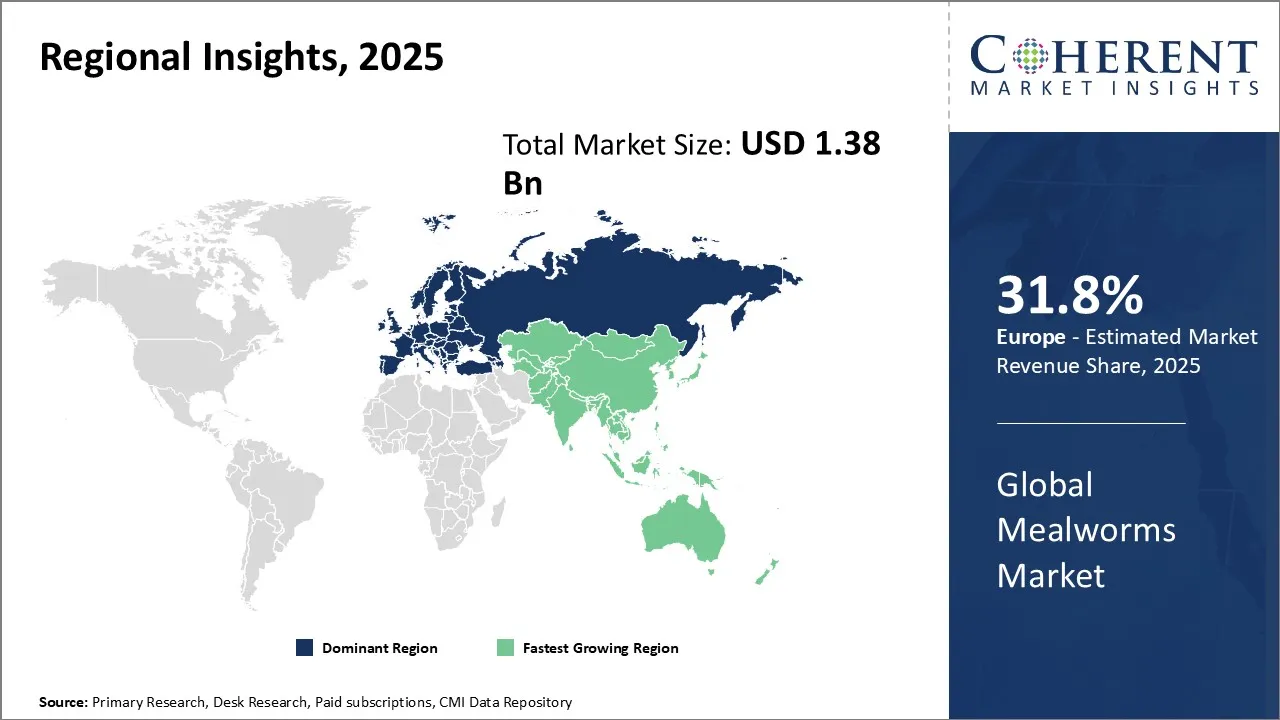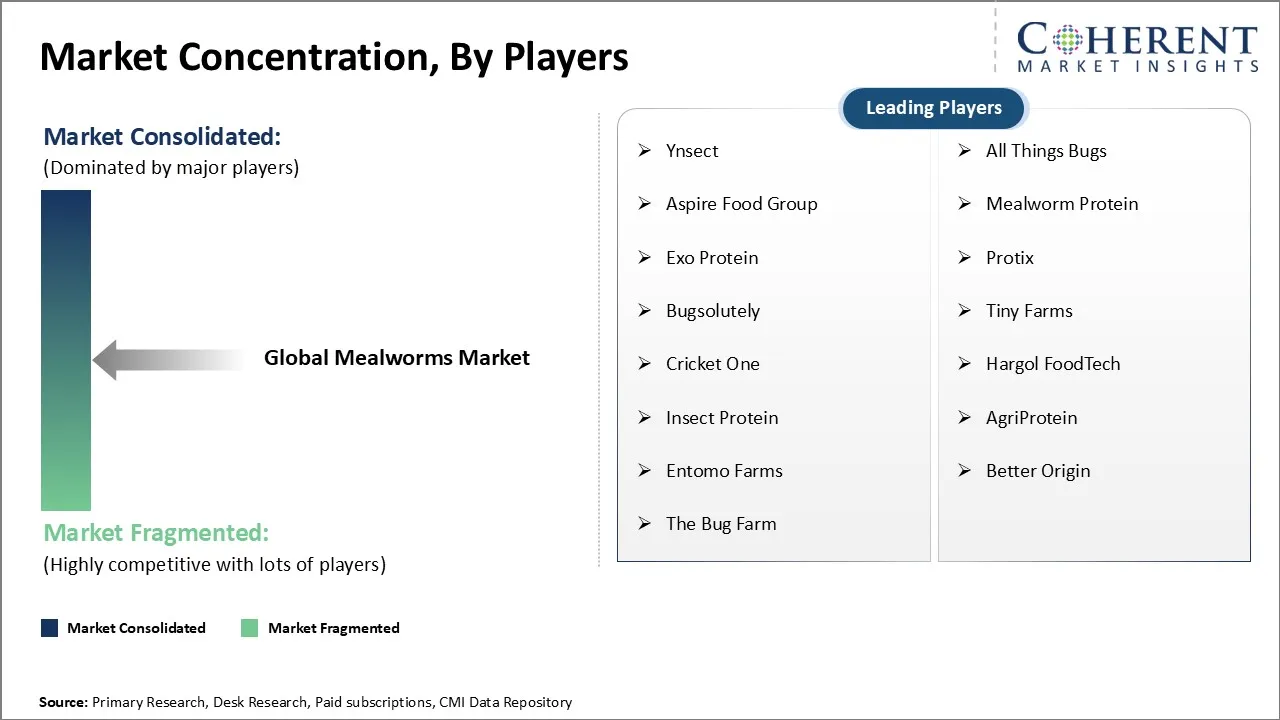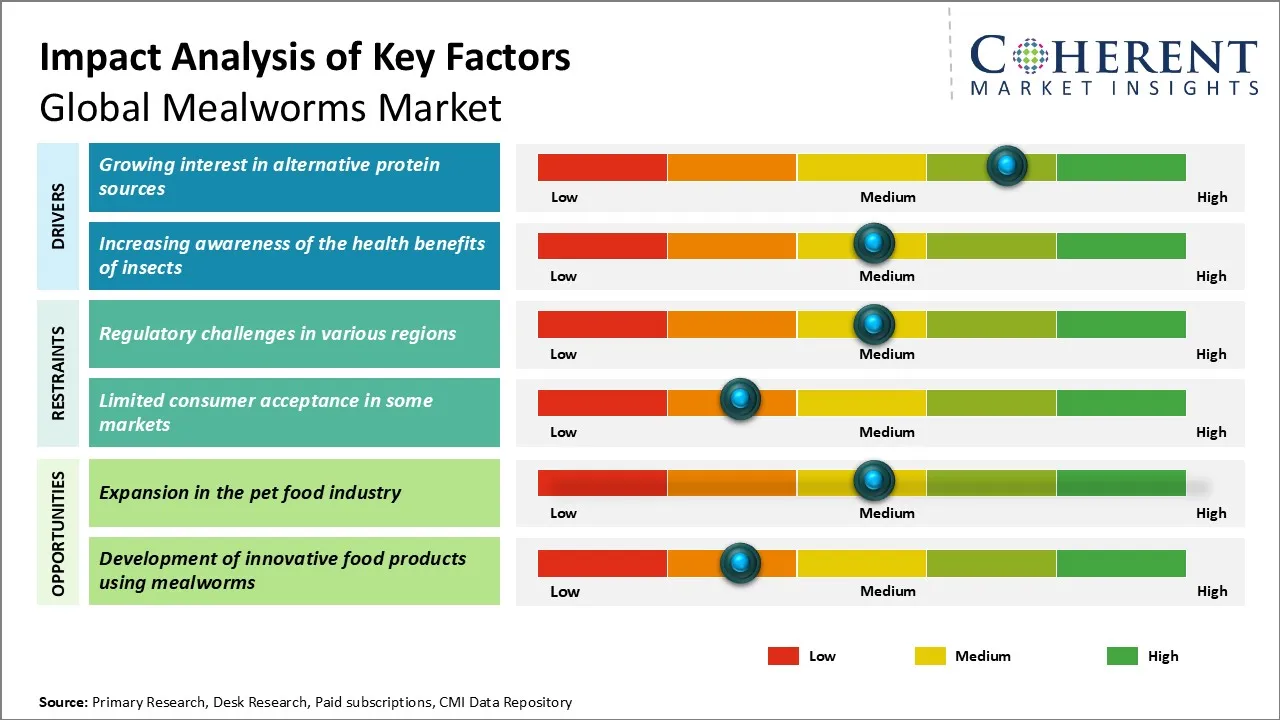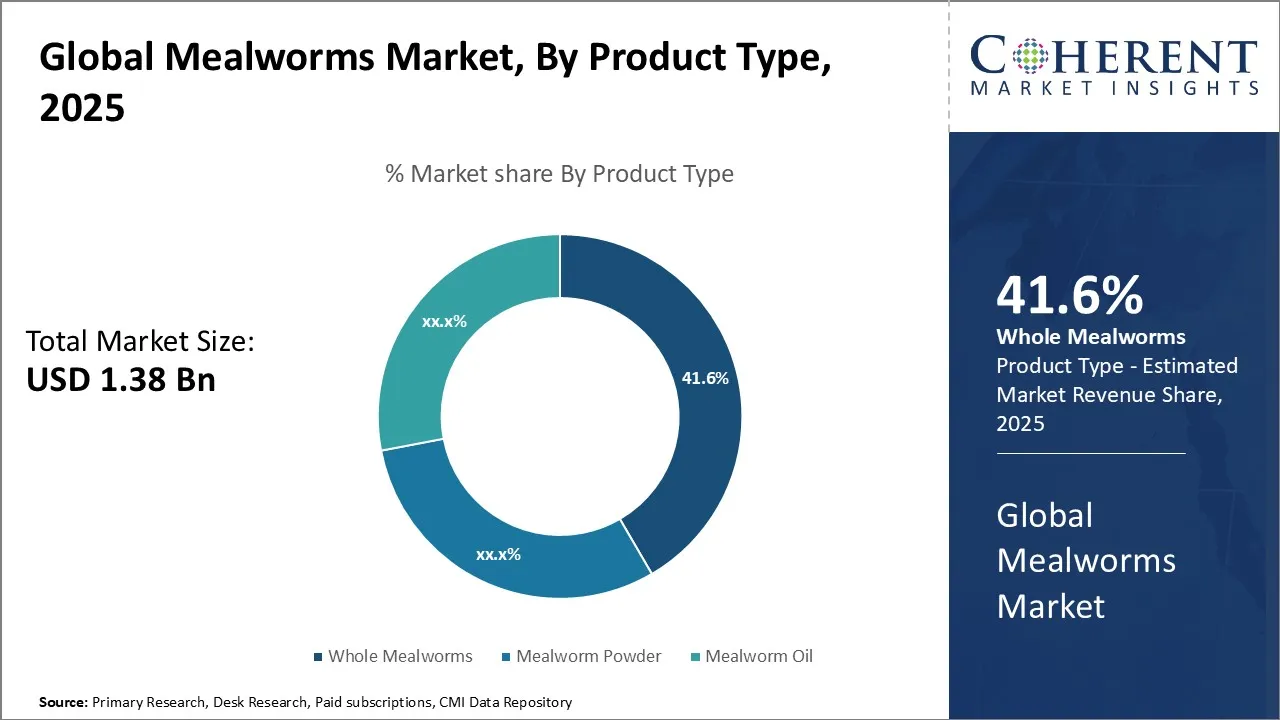Global Mealworms Market Size and Forecast – 2025-2032
The Global Mealworms Market is estimated to be valued at USD 1.38 Bn in 2025 and is expected to reach USD 7.15 Bn by 2032, growing at a compound annual growth rate (CAGR) of 26.5% from 2025 to 2032.
Key Takeaways of the Mealworms Market
- The whole mealworms segment is projected to account for 41.6% of the global mealworms market in 2025, driven by their versatility and high nutritional value.
- The food and beverages segment is expected to hold 34.5% of the market in 2025, driven by increasing demand for alternative proteins and innovative food products.
- The online retail segment is expected to lead the global mealworms market in 2025 with a 32.7% share, driven by its convenience, broad reach, and ability to meet niche dietary demands.
- Europe is expected to lead the global mealworms market in 2025 with a 31.8% share, driven by increasing demand for alternative protein sources, sustainable food products, and the growing interest in plant-based diets. Asia Pacific, with a 9.5% share in 2025, is projected to be the fastest-growing region, fueled by rising disposable incomes, expanding middle-class populations, and the growing adoption of insect protein in food and feed applications.
Market Overview
Market trends indicate a rising demand for sustainable and environmentally friendly protein options, positioning mealworms as a promising solution in the food and feed industries. Innovations in farming technology and processing methods are enhancing mealworm production efficiency, while growing consumer awareness about ecological impacts and health benefits is propelling market expansion. Additionally, regulatory support and increased investments in insect-based protein research further bolster the market’s upward trajectory.
Current Events and Its Impact
|
Current Events |
Description and its impact |
|
EU Approval of Mealworm Powder in Foods |
|
|
Technological Advancements in Insect Farming |
|
Uncover macros and micros vetted on 75+ parameters: Get instant access to report
Mealworms Market Insights, By Product Type - Whole Mealworms Segment Leads Due to Versatility and Nutritional Richness
The whole mealworms segment is expected to contribute 41.6% share of the global mealworms market in 2025, largely owing to their versatility and nutritional density. Whole mealworms offer a complete protein source, containing essential amino acids, healthy fats, vitamins, and minerals, making them a highly sought-after ingredient for various end uses. Unlike processed forms such as mealworm powder or oil, whole mealworms are often favored for their minimal processing and natural composition, which appeals to consumers seeking clean-label and sustainable protein options.
One of the primary growth drivers for whole mealworms is their use in both human food and animal feed applications. For human consumption, whole mealworms can be roasted, fried, or incorporated into snack products, offering a familiar texture and shape that can be easily marketed to adventurous or health-conscious consumers. Their presentation as whole insects provides transparency to consumers about the ingredient’s natural state, which enhances trust and acceptance in emerging markets focused on entomophagy.
Mealworms Market Insights, By Application - Food and Beverages Segment Leads Market Share Fueled by Increasing Protein Demand and Novel Food Trends
Food and beverages segment is projected to contribute 34.5% share of the market in 2025, due to growing the intensified demand, and commands the largest market share, due to growing consumer interest in alternative protein sources and innovative food products. The rising awareness of the benefits of insects as a sustainable and nutritious protein resource has embedded mealworms as a key ingredient in novel food formulations ranging from protein bars to baked goods and ready-to-eat snacks.
Mealworms Market Insights, By Distribution Channel - Online Retail Dominates Distribution Channel Owing to Convenience and Expanding Consumer Reach
Online retail segment is expected to lead with 32.7% share of the global mealworms market in 2025, driven by its unmatched convenience, extensive reach, and ability to cater to niche dietary needs. The adoption of e-commerce platforms allows manufacturers and suppliers to connect directly with a growing base of consumers seeking sustainable, ethical protein alternatives without geographic limitations.
The convenience factor is paramount; customers can purchase mealworm products from their homes with detailed product information, customer reviews, and transparent sourcing practices at their fingertips. Online platforms also facilitate the preview of a wide variety of products—ranging from whole mealworms to powders and oils—allowing consumers to compare and select items tailored to their preferences, dietary goals, and cooking styles.
Regional Insights

To learn more about this report, Download Free Sample
Europe Mealworms Market Analysis and Trends
The Europe region is projected to lead the market with a 31.8% share in 2025, driven largely by the region's advanced food safety regulations, robust sustainability initiatives, and growing consumer awareness regarding alternative protein sources. Countries in Europe have well-established industry ecosystems that support mealworm farming and processing, supplemented by strong government policies promoting insect-based proteins as a sustainable and nutritious solution to future food security challenges. The European Union’s regulatory framework provides clear guidelines for edible insects, which fosters innovation and product development.
For example, Protix (Netherlands) and Ynsect (France) are key players in large-scale mealworm production, driving market growth through partnerships and investments in insect protein for pet food and human consumption. In April 2021, Ynsect acquired Protifarm, a Dutch company specializing in mealworm-based ingredients for human use, expanding its product range and production capacity in the insect-based food sector.
Asia Pacific Mealworms Market Analysis and Trends
The Asia Pacific region is expected to exhibit the fastest growth in the market, contributing 9.5% share in 2025, propelled by increasing demand for sustainable protein amid rising populations and urbanization challenges. The region’s vast agricultural base and low-cost production capabilities support the scaling up of mealworm farming. Additionally, government initiatives in countries like China and India encourage the adoption of insect protein to address food security and environmental concerns.
The presence of local startups such as Eat Grub in Australia and Bugsolutely in Thailand showcases innovation and growing consumer acceptance in both food and feed sectors. The Asia Pacific’s diverse consumption culture, combined with increasing awareness, is contributing to rapid market expansion. Moreover, expanding export opportunities to neighboring countries further amplify trade dynamics in this region.
Global Mealworms Market Outlook for Key Countries
Netherlands Mealworms Market Trends
The Netherlands is a key player in the global mealworms market, leveraging its innovative agri-food ecosystem and research institutions that focus on insect protein technologies. Dutch companies like Protix and Micronutris are critical in scaling mealworm production, developing high-quality protein ingredients used in animal feed and specialty foods. The nation’s efficient supply chains and export-oriented strategies make it a hub for European distribution. Government funding and favorable policies toward circular food practices further bolster the Netherlands’ leadership in mealworms market development.
China Mealworms Market Trends
China’s mealworms market benefits from supportive government policies aimed at enhancing food security and sustainability. Several emerging companies and research centers are investing in mealworm farming technology to provide alternative protein to animal feed industries, driven by growing livestock sector demands. The country’s large-scale farming capabilities and growing consumer base are key to rapid commercialization. Additionally, increasing urban demand for novel protein foods is pushing manufacturers to innovate mealworm-based snacks and supplements, positioning China as a major growth market within Asia Pacific.
U.S. Mealworms Market Trends
The U.S. continues to lead mealworms market initiatives through innovation in food tech and increasing acceptance of novel protein sources. Companies such as Aspire Food Group and Exo Protein are instrumental in mainstreaming edible insects via new product launches and partnerships with food service providers. Regulatory progress by the FDA in clarifying insect protein use in foods and feeds contributes to steady expansion. The U.S. consumer trend toward health and sustainability aligns well with mealworm products, creating fertile ground for market growth supported by agricultural innovation hubs and venture capital investment.
Thailand Mealworms Market Trends
Thailand’s mealworms market is gaining traction as a culturally accepted food source, with many local startups focusing on value-added food products such as crispy snacks and protein bars. Government endorsement of insect farming as an economic opportunity for rural communities strengthens local supply chains. Companies like Bugsolutely are not only advancing production scale but also emphasizing sustainability messaging that resonates with young urban consumers. Thailand’s strategic location enables access to broader Southeast Asian markets, helping to extend its influence in the region.
Germany Mealworms Market Trends
The market in Germany is characterized by sophisticated research, consumer awareness, and regulatory clarity that support the integration of mealworms into mainstream food and feed sectors. German firms like Entomo Farms and InnovaFeed partner with academia and retailers to develop inclusive value chains that address consumer preferences and regulatory compliance. Environmental sustainability, animal welfare, and organic certification standards play a significant role in driving product development and market penetration. Germany’s leadership in innovation and sustainability ensures its strong position in the European and global mealworms market.
End User Feedback and Unmet Needs: Mealworms Market
Positive User Experience: Sustainable Protein in Animal Feed: In the animal feed sector, end users have expressed satisfaction with the nutritional value and sustainability of mealworms as a protein source. A prominent feed manufacturer in Europe has praised mealworms for their ability to replace traditional protein sources such as fishmeal and soybean, which are becoming increasingly expensive and less sustainable. Mealworms are not only a cost-effective alternative, but they also align with the growing demand for eco-friendly solutions in livestock and aquaculture feed.
Common Concern: Challenges in Large-Scale Mealworm Production: Despite the positive feedback, end-users, particularly those in the industrial scale production of mealworm-based products, frequently report concerns related to the scalability of production processes. One common limitation involves the lack of sufficient automation in mealworm harvesting and processing. An industrial-scale producer based in North America noted that although mealworm farming is seen as a sustainable and profitable business, the labor-intensive harvesting process poses a significant bottleneck. The need for manual intervention at multiple stages, from breeding to harvesting, limits the operational efficiency and increases the cost of production.
Market Players, Key Development, and Competitive Intelligence

To learn more about this report, Download Free Sample
Company Insights
- Ynsect is a leading company in the mealworms market, specializing in the production of insect-based protein for animal feed, pet food, and plant fertilizers. The company primarily focuses on mealworms, which are known for their high nutritional value and sustainable production methods. Ynsect leverages cutting-edge biotechnologies and innovative farming systems to farm mealworms at scale. By utilizing its proprietary vertical farming technology, it optimizes the efficiency of mealworm production while minimizing the environmental footprint.
- Entomo Farms is a Canada-based company specializing in the sustainable production of insect-based protein, particularly from crickets. While its primary focus is on crickets, it also offers mealworm products, catering to the growing demand for alternative protein. Entomo Farms provides a range of products designed for human consumption, pet food, and animal feed. Its offerings include whole roasted and seasoned mealworms, available in flavors such as honey mustard, BBQ, and Moroccan, which are marketed as nutritious and environment-friendly snacks.
Top Strategies Followed by Global Mealworms Market Players
- Established companies leverage their substantial resources by investing heavily in research and development (R&D) to innovate high-performance mealworm products that meet evolving consumer demands and regulatory standards.
- For example, Ynsect, a prominent player in the global mealworms market, has invested significantly in R&D to develop a high-performance, sustainable protein sourced from mealworms. Their product offerings are marketed as nutritionally superior, with high protein content and lower environmental impact compared to traditional animal protein sources.
- Mid-level companies in the mealworms market adopt a distinct approach focused on delivering cost-effective solutions that strike a balance between quality and affordability. By targeting price-sensitive consumers, these players position themselves as accessible alternatives to premium products offered by established firms. To remain competitive, mid-tier firms often engage in collaborative ventures or joint ventures to enhance their production capabilities, scale operations, and acquire innovative technologies without exorbitant investments.
- For example, The Bug Foundation is a mid-sized company that supplies mealworm-based products for both animal feed and human consumption. While it does not have the same extensive R&D resources as larger players, it focuses on maintaining a competitive edge by offering affordable mealworm products with solid nutritional benefits.
- Small-scale players navigate the competitive landscape by carving out niches through specialized product features or unique innovations tailored to specific consumer needs. Many adopt cutting-edge technologies such as automated farming systems, genetic improvements, or novel processing techniques, to distinguish themselves from larger competitors and maintain agility in a fast-evolving market.
- For example, Little Herds, a U.S.-based company, produces high-quality, farmed mealworms for human consumption, with a focus on sustainable and organic farming practices. The company differentiates itself by marketing its mealworms as gourmet, organic, and ethically farmed, appealing to environmentally-conscious consumers.
Market Report Scope
Mealworms Market Report Coverage
| Report Coverage | Details | ||
|---|---|---|---|
| Base Year: | 2024 | Market Size in 2025: | USD 1.38 Bn |
| Historical Data for: | 2020 To 2024 | Forecast Period: | 2025 To 2032 |
| Forecast Period 2025 to 2032 CAGR: | 26.5% | 2032 Value Projection: | USD 7.15 Bn |
| Geographies covered: |
|
||
| Segments covered: |
|
||
| Companies covered: |
Ynsect, All Things Bugs, Aspire Food Group, Mealworm Protein, Exo Protein, Protix, Bugsolutely, Tiny Farms, Cricket One, Hargol FoodTech, Insect Protein, AgriProtein, Entomo Farms, Better Origin, and The Bug Farm |
||
| Growth Drivers: |
|
||
| Restraints & Challenges: |
|
||
Uncover macros and micros vetted on 75+ parameters: Get instant access to report
Mealworms Market Dynamics

To learn more about this report, Download Free Sample
Mealworms Market Driver - Growing Interest in Alternative Protein Sources
The growing awareness of sustainability, health, and environmental impacts is boosting the demand for alternative protein sources like mealworms. Traditional livestock farming has high greenhouse gas emissions, emissions trading, land use, and water consumption, prompting the search for eco-friendly, nutrient-rich options. Mealworms, rich in protein, amino acids, vitamins, and minerals, are a sustainable choice with a lower carbon footprint. According to the Food and Agriculture Organization (FAO), mealworms require 2,000 times less water than beef and emit significantly fewer greenhouse gases, making them an efficient, sustainable alternative to conventional meat.
Mealworms Market Opportunity - Expansion in the Pet Food Industry
The global mealworms market presents a significant opportunity through its expanding application in the pet food industry. With increasing consumer awareness about sustainable and high-protein alternatives, mealworms have gained traction as a novel ingredient in pet, animal nutrition, especially for dogs, cats, birds, and exotic pets. Mealworms offer an excellent source of protein, essential amino acids, and micronutrients, making them a nutritionally beneficial and eco-friendly substitute for traditional animal-based proteins such as fishmeal and poultry by-products. The rising trend of pet humanization is driving demand for premium, natural, and ethically sourced pet foods, creating a favorable environment for the incorporation of insect-based proteins like mealworms.
Analyst Opinion (Expert Opinion)
- The mealworms market is poised for explosive growth, driven by the increasing interest in sustainable protein sources and the rising demand for alternative animal feed. Companies like Ynsect and Aspire Food Group are leading innovations in mealworm farming and processing technologies, enhancing efficiency and scalability. Recent conferences, such as the Edible Insects Conference (2023) and the International Conference on Insect Agriculture (2022), have underscored the nutritional benefits of mealworms, including their high protein content and low environmental impact compared to traditional livestock.
- These events have also showcased successful applications of mealworms in human food products and as feed for aquaculture and poultry, highlighting their versatility. As consumers and industries seek sustainable solutions to food security challenges, the mealworms market is well-positioned for significant expansion, driven by innovations that meet both nutritional needs and environmental sustainability goals.
Market Segmentation
- Product Type Insights (Revenue, USD Bn, 2020 - 2032)
- Whole Mealworms
- Mealworm Powder
- Mealworm Oil
- Application Insights (Revenue, USD Bn, 2020 - 2032)
- Food and Beverages
- Animal Feed
- Nutraceuticals
- Cosmetics
- Others
- Distribution Channel Insights (Revenue, USD Bn, 2020 - 2032)
- Online Retail
- Supermarkets/Hypermarkets
- Health Food Stores
- Specialty Stores
- Regional Insights (Revenue, USD Bn, 2020 - 2032)
- North America
- U.S.
- Canada
- Latin America
- Brazil
- Argentina
- Mexico
- Rest of Latin America
- Europe
- Germany
- U.K.
- Spain
- France
- Italy
- Russia
- Rest of Europe
- Asia Pacific
- China
- India
- Japan
- Australia
- South Korea
- ASEAN
- Rest of Asia Pacific
- Middle East
- GCC Countries
- Israel
- Rest of Middle East
- Africa
- South Africa
- North Africa
- Central Africa
- North America
- Key Players Insights
- Ynsect
- All Things Bugs
- Aspire Food Group
- Mealworm Protein
- Exo Protein
- Protix
- Bugsolutely
- Tiny Farms
- Cricket One
- Hargol FoodTech
- Insect Protein
- AgriProtein
- Entomo Farms
- Better Origin
- The Bug Farm
Sources
Primary Research Interviews
- Product Development Manager – Leading Mealworm-Based Food Product Manufacturer
- Marketing Head – Major Mealworm Supply Distributor
- Sustainability Officer – Mealworm Farming Certification Body
- Procurement Director – International Mealworm Exporter
- Consumer Behavior Analyst – Market Research Firm (specializing in alternative proteins)
Stakeholders
- Manufacturers
- End-use Sectors:
- Food & Beverages: Mealworm-based protein snacks, alternative protein products
- Animal Feed: Mealworm flour used in animal feed formulations
- Agriculture: Mealworms as sustainable fertilizer and soil enhancement products
- Pet Food Industry: Companies using mealworm protein in pet foods
- Regulatory & Certification Bodies:
- FDA (Food and Drug Administration) for food safety standards in mealworm-based products
- EFSA (European Food Safety Authority) for approval and safety standards
- Food Standards Australia New Zealand (FSANZ) for mealworm usage in animal feed
- E-commerce Platforms and Retailers: Online and offline distributors of mealworm-based products
- Technology Integration Players: AI-based supply chain optimization, insect farming technologies, sustainability certification technologies
Databases
- UN Comtrade Database
- India Import Export (EXIM) Database
- FAOSTAT – Food and Agriculture Organization of the United Nations’ statistical data
Magazines
- Insect Protein Today – Magazine focused on edible insects as protein sources, including mealworms
- Sustainable Food Systems Journal – Trends in sustainable food sources, including insect-based nutrition
- Food and Beverage Technology Magazine – Innovations in food technology, including mealworm processing
- The Mealworm Report – Industry news and insights into mealworm farming and consumption
Journals
- Journal of Insects as Food and Feed – Research on the nutritional benefits and processing of edible insects
- Food Research International – Articles on food safety, bioavailability, and nutritional benefits of mealworms
- International Journal of Food Science & Technology – Studies on mealworm protein in food formulations
- Journal of Agricultural and Food Chemistry – Research on nutrient composition in mealworms
- Trends in Food Science & Technology – Mealworm protein market dynamics and trends
Newspaper
- The Financial Times
- The Guardian
- Asia Health Journal
- The New York Times
Associations
- Council for Responsible Nutrition (CRN)
- International Society for Insect Ecology (ISIE) – Insect farming and environmental impact
- Edible Insects Global Network (EIGN) – Networking and insights into edible insect industry, including mealworms
- The Natural Products Association – Industry standards and regulations for alternative proteins
- European Food Safety Authority (EFSA) – Regulatory body for food safety, including insect-based foods
Public Domain Sources
- FDA – Guidelines for edible insects and mealworm-based food products
- EFSA – Food safety and nutritional assessment of mealworm-based food products
- World Health Organization (WHO) – Health and safety guidelines for consumption of insect-based foods
- OECD – Sustainability assessments for edible insect-based food production and consumption
Proprietary Elements
- CMI Data Analytics Tool, Proprietary CMI Existing Repository of information for last 8 years.
Share
Share
About Author
Sakshi Suryawanshi is a Research Consultant with 6 years of extensive experience in market research and consulting. She is proficient in market estimation, competitive analysis, and patent analysis. Sakshi excels in identifying market trends and evaluating competitive landscapes to provide actionable insights that drive strategic decision-making. Her expertise helps businesses navigate complex market dynamics and achieve their objectives effectively.
Missing comfort of reading report in your local language? Find your preferred language :
Transform your Strategy with Exclusive Trending Reports :
Frequently Asked Questions
EXISTING CLIENTELE
Joining thousands of companies around the world committed to making the Excellent Business Solutions.
View All Our Clients


